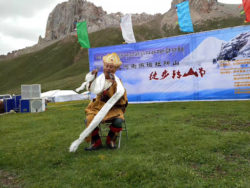From Heritage to Sustainability on the Tibetan Plateau
Danma Jamyang Tsultrim, a retired teacher and elderly narrator of the Tibetan Gesar epic, sits adjacent to me in a restaurant in Ziling City, an audio recorder perched precariously on the arm of my chair. He tells me that he has loved the story of King Gesar of Ling—sometimes touted as the longest epic in the world—since he first heard it being performed as a child. For several decades, he has devoted himself to re-telling the epic and to developing new editions of the epic, often with little material reward. His efforts have been officially recognized by the Chinese government with designation as a “national-level reading artist” of the Gesar epic (Ch, 国家级吟诵艺人).
However, Danma Jamyang Tsultrim is concerned for the epic’s future in his home area of Yushu Tibetan Autonomous Prefecture. Yushu is a part of the ethnolinguistic region of Tibet known as Kham. The rest of Yushu’s parent province, Qinghai, is part of Amdo, and Jamyang Tsultrim feels that even though the government is intent on protecting the Gesar epic, resources go to Amdo Tibetan communities and bards because most of the people responsible for the epic in the provincial and national levels are from Amdo. “They can’t understand the Yushu Gesar,” he told me. And so, they devalue it.

A Gesar bard performs in Yushu Tibetan Autonomous Prefecture
Things weren’t always this way. Traditionally, bards had little need to compete with each other, and the epic was densely interwoven into Tibetan everyday lives and environments. But in the People’s Republic of China, the Gesar epic has been a focus of political and academic work, especially since the early 1980s. A tremendous amount of effort has gone into identifying bards, and creating textual editions of their repertoires. When the epic was inscribed on UNESCO’s “Representative List of the Intangible Cultural Heritage of Humanity,” the millions of RMB suddenly available for safeguarding the epic turned the epic into a high stakes competition for official recognition. It is a competition that many Yushu Tibetans feel that they have lost: funding and recognition go elsewhere, communities and individuals compete over what funds there are, and safeguarding efforts focus primarily on the best-known aspects of the tradition, rather than the range of practices that make the epic such an important part of the regional culture interwoven into all aspects of Tibetan life.
The Gesar epic is just one hundreds of traditions around China, and around the world that has received some sort of formal recognition as ‘intangible cultural heritage’ feiwuzhiwenhua yichan 非物质文化遗产). However, like Danma Jamyang Tsultrim, scholars and community stakeholders across the globe have recognized that heritage designation often fails to protect a tradition’s vitality. This is not least because “heritage” focuses on individual traditions rather than communities and separates traditions from the dynamic contexts of which they are a part. Given the tremendous precarity of many intangible cultural traditions, a new framework is needed to truly support the health and vitality of cultural practices, and the communities that maintain them. Enter “Cultural sustainability.”
Stemming primarily from the fields of ethnomusicology and folkloristics, “cultural sustainability” seeks to advance approaches to traditions. Some of the research (for example, Schippers and Grant’s Sustainable Futures for Music Cultures, listen to my conversation with Schippers here) continues to focus on individual traditions within broader, dynamic contexts, finding that prestige is one of the key factors in keeping traditions alive. For others, like Jeff Todd Titon, the focus of cultural sustainability is on holistically maintaining the health and resilience of the cultural ecosystem (see, for example, this article). This requires new methods for assessing supporting and the vitality of individual traditions and of the cultural ecosystem more generally.
The Tibetan Sustainable Heritage Initiative (TaSHI, after the Tibetan བཀྲ་ཤིས། meaning auspiciousness) aims to develop new ways of working with community stakeholders to co-create sustainable futures for minoritized communities and traditions at a moment of incredible upheaval. From the carving of holy stones to epic and proverb lore, to festivals and rituals, we will examine traditions from across the Tibetan Plateau to better understand cultural vitality and sustainability. An initial assessment of the Gesar epic's vitality (written before the coronavirus pandemic) can be found here. Over the coming years, this blog will document some of the activities, ideas, and findings of the TaSHI team and our partners. These will update about new project activities and publications, share new media creations, and flesh out our definitions and findings about cultural sustainability. Stay tuned!
